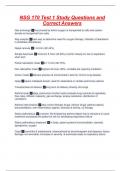NSG 170 Test 1 Study Questions and
Correct Answers
Gas exchange ✅the process by which oxygen is transported to cells and carbon
dioxide is transported from cells
Abg analysis ✅best way to determine need for oxygen therapy, indicator of alterations
in acid/base disturbance
Nasal cannula ✅1-6 l/min (22-44%)
Simple facemask ✅minimum 5 l/min (40-60%) monitor closely for risk of aspiration;
short term
Partial rebreather mask ✅6-11 l/min (60-75%)
Non-rebreather mask ✅highest o2 level >90%; unstable pts requiring intubation
Venturi mask ✅delivers precise o2 concentration; best for chronic lung disease
Cpap ✅opens collapsed alveoli; used for atelectasis or cardiac-pulmonary edema
Transtracheal o2 delivery ✅long term o2 delivery directly into lungs
Asthma tests ✅abgs, pulmonary function tests (evaluate lung volumes & capacities,
flow rates, diffusion capacity, gas exchange, airway resistance, distribution of
ventilation)
Asthma interventions ✅daily control therapy drugs, reliever drugs (asthma attack),
bronchodilators, anti-inflammatory agents, exercise & activity, o2 therapy
Status asthmaticus ✅a severe, life-threatening asthma attack that is refractory to usual
treatment and places the patient at risk for developing respiratory failure.
Status asthmaticus treatment ✅iv fluids, potent systemic bronchodilator, steroids,
epinephrine, oxygen
Copd ✅bronchitis & emphysema: characterized by bronchospasm and dyspnea; tissue
damage not reversible, increases in severity, & eventually leads to respiratory failure
, Emphysema ✅loss of lung elasticity, hyperinflation of lung, dyspnea, air trapping,
increased rr, caused when alveolar walls are destroyed causing permanent
enlargement
Cor pulmonale ✅right-sided heart failure arising from chronic lung disease
Chronic bronchitis ✅inflammation of bronchi & bronchioles, caused by chronic
exposure to irritants, inflammation, vasodilation, congestion, mucosal edema,
bronchospasm, production of thick mucus, affects only airways
Complications of copd ✅hypoxemia/tissue anoxia, acidosis, respiratory infections,
cardiac failure/cor pulmonale, cardiac dysthymias
Copd tests ✅abgs, sputum, cbc, hgb & hct, serum electrolytes, serum aat, chest xray,
pulmonary function test
Copd analysis ✅decreased gas exchange, weight loss, anxiety, decreased endurance,
potential for pneumonia
Copd management ✅breathing techniques, positioning, effective coughing, o2 therapy,
drug therapy, exercise conditioning, suctioning, hydration
Copd drugs ✅beta-adrenergic agents
Cholinergic antagonists
Methylxanthines
Corticosteroids
Nsaids
Mucolytics
Copd surgery ✅-lung volume reduction surgery
-lung transplant
Anticlotting forces ✅plasminogen -> plasminogen activators & thrombin -> plasmin
(active form of plasminogen) -> digestion -> fibrin clot -> fibrin degradation products
Anemia assessment ✅pt history, meds, nutritional status, family history, genetic risk,
current health problems
Anemia tests ✅peripheral blood smear, cbc, reticulocyte count, hgb electrophoresis,
coomb's test, serum ferritin, transferrin, & tibc, pt, inr, ptt, anti-factor xa test, platelet
aggregation
Differences in child's respiratory system ✅lack of or insufficient surfactant,
Smaller airways and underdeveloped cartilage, obligatory nose breather,




